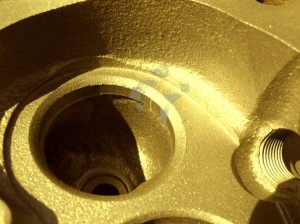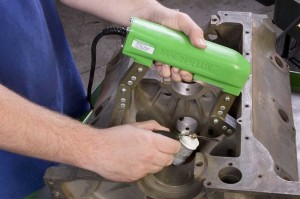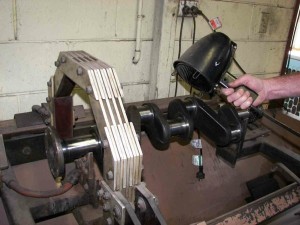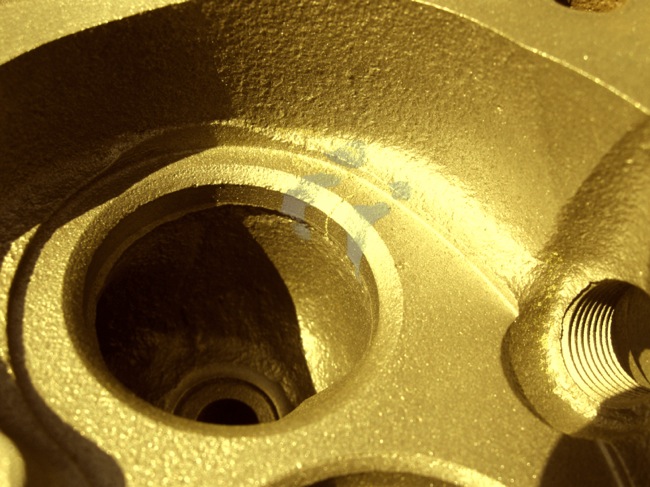Salvaging Cracked or Flawed Engine Parts through Detection and Repairs
Cracks are often blamed as the cause of a head failure. In many instances, the cracks are not the cause of the failure, but a symptom of another underlying problem such as overheating, detonation or incorrect installation (wrong torque on head bolts, dirty bolt threads, etc.).

The good news is that cracks do not necessarily mean a cylinder head has to be replaced. In fact, many cracked heads that were once thought to be “unrepairable” are now being fixed. Repairing a cracked cylinder head always involves a certain amount of risk, but when done properly is usually much less expensive than replacing a cracked head with a new or used casting.
Today’s engine builders have available to them a number of state-of-the-art tools and techniques to locate, identify and repair cracks and other damage in a
variety of engine components. However, without excellent crack detection and repair methods, relying on good ol’ 20/20 eyesight may not be enough.
Finding a crack isn’t necessarily a bad thing – not looking for them definitely is.
Crack Happens
Depending on their locations, crack severity will vary. They tend to form, spread and get worse as heat, thermal stress, heavy loads, repeated bending and flexing, metal fatigue, pounding and vibration take their toll on a part. Cracking is an indication that an area is experiencing more stress than it can handle.
Finding those cracks will enable you to determine whether you should repair or replace those parts. You simply can’t afford to spend a lot of time machining or reconditioning cores or used parts that may be destined for failure.
With hard-to-find and high value cores and parts, the decision may hinge on the extent of the damage. If the part can be repaired economically and with a high degree of success, then it’s probably worth fixing. But if it can’t, you’ll have to factor in the cost to replace it.
Always assume there may be cracks – although, because engine parts are made of so many different materials these days, finding them may be a challenge.

Detecting Cracks
The following are some helpful procedures your builders can use to help detect cracks, flaws or other anomalies that can be repaired (at a price), and prevent engine damage down the road.
Magnetic Particle Inspection: Magnetic particle inspection is most often used to inspect cast iron or steel alloys that are “ferromagnetic” and can be temporarily magnetized for such things as surface cracks in and around the cylinder head combustion chambers and for inspecting crankshafts, camshafts and connecting rods. But the technique can also be used to check gears, shafts, axles and steering and suspension components for cracks, too.
Magnetic particle inspection won’t work on nonferrous metals such as aluminum, magnesium, titanium, nonmagnetic alloys of stainless steel or plastic.
A magnetic field created in various ways causes tiny iron oxide particles that are sprayed or brushed on the part to reveal any cracks. If there are any cracks in the surface of the part, they will disrupt the magnetic field and act like a pole to attract the iron particles.
The iron particles (sized between .125” and 60 microns), may be applied in a dry powder or a wet solution. They can be dyed yellow, white, red, gray, black or other fluorescent color to improve their visibility against the metal background. With the fluorescent particles, an ultraviolet black light is required to make the particles stand out.
The wet particle detection method is more sensitive than the dry method for finding very small cracks, but dry particles are better for finding cracks that may be just under the surface (subsurface flaws).
The light, size of the particle and even the type of electrical current your equipment can produce can impact your ability to find cracks and other anomalies.
Remember, for this method, the training of the operator is imperative, and so is part cleanliness.

Dye Penetrant Inspection: Though used mostly on aluminum parts, this technique also works well on cast iron, steel, composite materials and even plastic.
The theory behind this technique is that a very light oil will wick into a crack. It’s the same idea as using penetrating oil to loosen a fastener except that the oil contains a dye. If the oil finds its way into a crack, the dye should then make the crack visible. Some penetrating dyes use fluorescent dyes and a black light to make the cracks stand out, while others use a chemical developer to make the dye more visible.
Several different styles of penetrant are available, depending on your needs. If you’re using a UV light and fluorescent dye, a shroud that blocks ambient light will make it easier to see the cracks.
Cracks will glow green under the black light. With ordinary dyes, no special light is needed. Cracks usually stand out as a stark red line against the bright aluminum metal.
Multi-stage penetrating dyes typically use a three-step process to highlight cracks.
The advantage of this process is that it is simple to do and can be used with non-ferrous metals. However, the drawbacks to the process are that it can only locate cracks or defects that break the surface of the part, it may be less sensitive than some other methods, it uses a relatively large amount of solution and may take extra time to complete testing.
Note: While magnetic particle inspection and penetrating dyes can do a good job revealing surface cracks, neither technique can effectively look below the surface or find damage hidden inside a casting. In this case, pressure testing will help you see what’s going wrong inside the engine.
Vacuum Testing: This is the same basic idea as pressure testing, except in reverse. Instead of using air pressure to test the cooling jackets for leaks, vacuum is used on a head or block after the water outlets have been plugged. If the casting holds vacuum, there are no leaks. But if it doesn’t, you’ve found a leaker.
Unfortunately, this technique does not use water or dye to pinpoint the leak, so you still have to use one of the other techniques to find the leak. It’s mostly a quick check for verifying the integrity of a casting.
Ultrasonic Testing: More commonly used in industrial and aviation applications, ultrasonics can also be used to find internal flaws in castings and other parts. The technology uses sound waves to find cracks. A transponder generates an acoustic signal (up to 25 MHz) that passes into and through the part. Cracks or flaws will reflect some of the sound waves back to the detector, which allows the information to be displayed on the tester.
The best applications for ultrasonic testing include heavy castings, large shafts and expensive parts that may be used for racing or extreme-duty service.
Ultrasonics can also be used to check the integrity of welds and welded castings. They can also be used to check for the integrity of cylinder wall thicknesses before or after boring.

And the Survey Says…
According to Engine Builder’s 2013 Machine Shop Market Profile, “Repair before replace” is an increasingly common mantra in some segments of the cylinder head business. Though production numbers have shown some declines, cylinder heads continue to be profitable in gas and diesel rebuild facilities.
Our research found that a smaller percentage of diesel heads are being scrapped (although aluminum heads continue to be scrapped at a higher rate). When they are repaired, rebuilders continue to leave the work to the experts.
Our survey results indicate that 36 percent of respondents say they do aluminum cylinder head crack repairs themselves and 35 percent do their own diesel head repair.
Welding is used as a repair method nearly 75 percent of the time with aluminum cylinder heads and 36 percent of the time with diesel heads.
Pinning remains the most-often used method for repairing diesel cylinder heads (done 65 percent of the time) but is used in only one-quarter of the aluminum head repairs.
Pinning is also the most commonly used technique for repairing cracks in cast iron heads because it’s fast, reliable and cheap. It can also be used to repair aluminum castings, too. Pinning is a relatively easy technique to learn and use, doesn’t require any special tools other than a drill, guide fixture and tap, and uses no heat.
The technique involves drilling holes in both ends of the crack to keep it from spreading, then drilling holes at various intervals along the length of the crack, installing overlapping pins to fill the crack, then peening over the pins with an air hammer to seal and blend the surface. Either tapered pins or straight pins may be used.
Tapered pins pull themselves into a crack as they are tightened to provide a tight seal along the entire length of the pin. This occurs because the threads on both the tapered pin and hole have an interference fit. Sealer really isn’t necessary, but may be used for added insurance. The holes for tapered pins must be carefully hand tapped with a tapered tap, and the pins hand tightened.
Straight pins, by comparison, can be installed with an ordinary straight tap and a power drill. Straight pins, however, must be sealed by a tapered shoulder on one end of the pin and/or with sealer.
Check out our Engine Builders Buyers Guides for pinning and welding tools and equipment.














